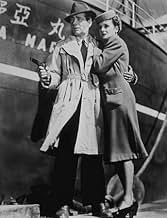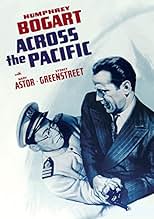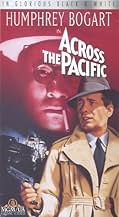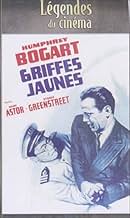VALUTAZIONE IMDb
6,8/10
5632
LA TUA VALUTAZIONE
Aggiungi una trama nella tua linguaIn December 1941, ex-army captain Rick Leland boards a Japanese ship heading to Asia via the Panama Canal where his Japanese hosts show interest in the American defense plans for the canal z... Leggi tuttoIn December 1941, ex-army captain Rick Leland boards a Japanese ship heading to Asia via the Panama Canal where his Japanese hosts show interest in the American defense plans for the canal zone.In December 1941, ex-army captain Rick Leland boards a Japanese ship heading to Asia via the Panama Canal where his Japanese hosts show interest in the American defense plans for the canal zone.
- Regia
- Sceneggiatura
- Star
- Premi
- 1 vittoria e 1 candidatura in totale
Victor Sen Yung
- Joe Totsuiko
- (as Sen Young)
Lee Tong Foo
- Sam Wing On
- (as Lee Tung Foo)
Recensioni in evidenza
WWII intrigue is served up in the days leading up to the bombing on Pearl Harbor. However, in an apparent late decision by the writers to not mention Pearl Harbor, the bombing target becomes Panama so history can be ignored. Bogart is cool as always as an artillery officer. He is reunited with his co-stars, Astor and Greenstreet, both in fine form, and director Huston from "The Maltese Falcon." Unfortunately, the script is rather convoluted and rambling, seemingly written in a rush to cash in on the success of the earlier film. The dialog is crisp and witty. If only the plot had been better, this could have been a classic.
Good WW2 spy movie with the three leads and director from The Maltese Falcon. The plot is about Humphrey Bogart getting tangled up with baddie Sydney Greenstreet and love interest Mary Astor. Greenstreet's a Japanese sympathizer and is trying to recruit Bogie. Good luck with that, Gutman. Bogart is excellent playing a character he was totally at home playing: wisecracking tough guy ladies' man. Greenstreet is villainous as ever and perfect at it. Just as in Maltese Falcon, Mary Astor is playing a stunning beauty that makes heads turn. Just like in Maltese Falcon, she doesn't match the character description. Perhaps Huston had a bit of a crush. Otherwise I don't get her being cast in these types of parts at a time when the likes of Ingrid Bergman and Lana Turner were around. Still, despite that element of the casting being off, Astor does fine.
This movie has an interesting backstory. It was originally to be about a Japanese attack on Pearl Harbor but when that actually happened in real life, they changed it to Panama. They never changed the title, though, despite the movie taking place nowhere near the Pacific. Then John Huston got called to serve before filming was complete so Vincent Sherman had to step in. Oddly, it seems Huston was the only one who knew how the movie was supposed to end so Sherman had to make up the final fifteen minutes or so of the movie!
This movie has an interesting backstory. It was originally to be about a Japanese attack on Pearl Harbor but when that actually happened in real life, they changed it to Panama. They never changed the title, though, despite the movie taking place nowhere near the Pacific. Then John Huston got called to serve before filming was complete so Vincent Sherman had to step in. Oddly, it seems Huston was the only one who knew how the movie was supposed to end so Sherman had to make up the final fifteen minutes or so of the movie!
A good spy caper starring Humphrey Bogart as Rick Leland, a court-martialled US Army officer who finds himself in the middle of a nifty little bit of espionage work on board a Japanese freighter bound from Halifax to Yokohama via the Panama Canal just before the attack on Pearl Harbour. Surrounded by a rather suspicious group of characters, from his love interest Alberta Marlow (Mary Astor) to Dr. Lorenz (Sydney Greenstreet), Leland slowly uncovers a Japanese plot to attack the Canal Zone (presumably also on December 7) and sets himself to preventing it.
This was a good performance by Bogart, along with good performances from Astor and Greenstreet. (For those not entirely familiar with Canadian geography, by the way, the pun is that Alberta claims to be from Medicine Hat, which is a small city in Alberta - almost TOO cute!) There's a fair amount of tension throughout as we struggle along with Leland to figure out exactly what's going on, and a nice climax as Leland foils the Japanese plan (Bogey had to win!)
A couple of things I thought were worth noting, though. First of all, what's with the title? All the action in the movie takes place either on the Japanese freighter as it travels south down the ATLANTIC coast of North America or in the Panama Canal Zone (with some minor scenes in Halifax, where Leland is rejected by the Canadian Army, and in New York City, where he snoops for information.) The only Pacific connection to the movie is that the freighter was Japanese. And remember, of course, that this was made in 1942 (after Pearl Harbour.) The depiction of the Japanese isn't especially flattering (although I thought it was more a play on stereotypes than openly antagonistic), and the closing shot of the film is the wartime requisite showing off of American military strength.
All in all, though, I enjoyed this movie immensely, and would highly recommend it.
8/10
This was a good performance by Bogart, along with good performances from Astor and Greenstreet. (For those not entirely familiar with Canadian geography, by the way, the pun is that Alberta claims to be from Medicine Hat, which is a small city in Alberta - almost TOO cute!) There's a fair amount of tension throughout as we struggle along with Leland to figure out exactly what's going on, and a nice climax as Leland foils the Japanese plan (Bogey had to win!)
A couple of things I thought were worth noting, though. First of all, what's with the title? All the action in the movie takes place either on the Japanese freighter as it travels south down the ATLANTIC coast of North America or in the Panama Canal Zone (with some minor scenes in Halifax, where Leland is rejected by the Canadian Army, and in New York City, where he snoops for information.) The only Pacific connection to the movie is that the freighter was Japanese. And remember, of course, that this was made in 1942 (after Pearl Harbour.) The depiction of the Japanese isn't especially flattering (although I thought it was more a play on stereotypes than openly antagonistic), and the closing shot of the film is the wartime requisite showing off of American military strength.
All in all, though, I enjoyed this movie immensely, and would highly recommend it.
8/10
This film contains many aspects of the noir, including the clipped bantering dialogue with the clever intent. Coming soon after The Maltese Falcon, Across the Pacific is something of a mystery movie too.
Rick Leland (Humphrey Bogart) is a disgraced military man with dubious loyalties. He gets on a Japanese ship that is sailing to New York City, the Canal Zone and the Orient. While onboard, he becomes familiar with the other passengers: a western businessman named Dr. Leland (Sydney Greenstreet) who has a penchant for all things oriental and a smalltown woman named Alberta (Mastor Astor) who is taking a pleasure cruise.
But we sense all is not as it seems. Will Rick sail off into the Japanese sunset, bitter at the country that snubbed him? Will the doctor reveal an insidious intent? Will Alberta prove to be more than a romantic foil for Rick?
The action takes place not long before the U.S. would be forced to enter the war. Tensions are high. Eventually there is gunplay and all motives are revealed. Along the way, ATP proves to be an interesting film. The ending reminded me of another film that would follow in 1959--North by Northwest. ATP is a high stakes game of cat and mouse that coexists with a lighthearted romance.
My one complaint is that Mary Astor is not an actress I think would inspire lust in Bogart's Rick. Someone like Rita Hayworth would better fit the bill.
Rick Leland (Humphrey Bogart) is a disgraced military man with dubious loyalties. He gets on a Japanese ship that is sailing to New York City, the Canal Zone and the Orient. While onboard, he becomes familiar with the other passengers: a western businessman named Dr. Leland (Sydney Greenstreet) who has a penchant for all things oriental and a smalltown woman named Alberta (Mastor Astor) who is taking a pleasure cruise.
But we sense all is not as it seems. Will Rick sail off into the Japanese sunset, bitter at the country that snubbed him? Will the doctor reveal an insidious intent? Will Alberta prove to be more than a romantic foil for Rick?
The action takes place not long before the U.S. would be forced to enter the war. Tensions are high. Eventually there is gunplay and all motives are revealed. Along the way, ATP proves to be an interesting film. The ending reminded me of another film that would follow in 1959--North by Northwest. ATP is a high stakes game of cat and mouse that coexists with a lighthearted romance.
My one complaint is that Mary Astor is not an actress I think would inspire lust in Bogart's Rick. Someone like Rita Hayworth would better fit the bill.
Films made around this time always have an interesting behind the scenes story, and "Across the Pacific" from 1942 is no different.
Rick Leland (Humphrey Bogart) is court-marshaled and booted out of the service; he then heads for Canada and attempts to enlist, but the Canadians know who he is and say they can't use him.
Leland then leaves on a Japanese ship for the Orient, making no bones about the fact that his talents are for sale! He meets an attractive woman, Alberta Marlow (Mary Astor) and one Dr. Lorenz (Sidney Greenstreet). Lorenz loves the Japanese and its people, and speaks the language very well.
You'll probably guess most of this.
This is a Maltese Falcon template, with the exception of the absence of Peter Lorre. John Huston directed, but when we entered the war, he left to do documentary films for the government. Vincent Sherman started the film at a difficult moment in the action, and he asked Huston how a particular situation would be resolved. Huston said, "That's your problem!" and left.
Originally this film had to do with stopping an attack on Pearl Harbor, but we all know what happened there, so the plot was changed to the Panama Canal.
I liked this film - there is a lot of light repartee between Bogart and Astor, which is fun and makes the film less intense than it might have been. They worked very well together. And you really can't beat Sidney Greenstreet when it comes to being slimy.
The majority of the Japanese in the movie were actually Chinese since most of the Japanese were interred, a black mark not often discussed, which is odd.
Some exciting action and solid work by all the cast.
Rick Leland (Humphrey Bogart) is court-marshaled and booted out of the service; he then heads for Canada and attempts to enlist, but the Canadians know who he is and say they can't use him.
Leland then leaves on a Japanese ship for the Orient, making no bones about the fact that his talents are for sale! He meets an attractive woman, Alberta Marlow (Mary Astor) and one Dr. Lorenz (Sidney Greenstreet). Lorenz loves the Japanese and its people, and speaks the language very well.
You'll probably guess most of this.
This is a Maltese Falcon template, with the exception of the absence of Peter Lorre. John Huston directed, but when we entered the war, he left to do documentary films for the government. Vincent Sherman started the film at a difficult moment in the action, and he asked Huston how a particular situation would be resolved. Huston said, "That's your problem!" and left.
Originally this film had to do with stopping an attack on Pearl Harbor, but we all know what happened there, so the plot was changed to the Panama Canal.
I liked this film - there is a lot of light repartee between Bogart and Astor, which is fun and makes the film less intense than it might have been. They worked very well together. And you really can't beat Sidney Greenstreet when it comes to being slimy.
The majority of the Japanese in the movie were actually Chinese since most of the Japanese were interred, a black mark not often discussed, which is odd.
Some exciting action and solid work by all the cast.
Lo sapevi?
- QuizDirector Vincent Sherman met with John Huston just before Huston left the project to join the United States Army Signal Corps to shoot documentaries for the war effort.
The two directors conferred just before they were about to shoot the scene in which Leland is trapped in the movie theatre and three assassins are trying to kill him.
"How does he get out?" Sherman asked. Huston replied, "That's your problem! I'm off to the war!"
John Huston then went off to join the war effort before the film was finished, taking the film script with him, explaining "Bogie will know how to get out." The studio's solution to the problem was to discard Huston's footage of the impossible dilemma and write a new scenario. Vincent Sherman directed the final scenes.
- BlooperThe background for the opening titles is a map of the Panama Canal. The orientation of the map and the compass is correct, but the labeling of the map is incorrect. In fact, the Atlantic end of the canal and the city of Colon are at the upper left (Northwest), and the Pacific end of the canal and Panama City are at the lower right (Southeast). The map is correctly labeled behind the closing credits.
- Citazioni
Rick Leland: [comparing his gun to Dr. Lorenz's, which he points at him] Remember: mine is bigger than yours!
- Curiosità sui creditiOpening Card:
Governor's Island
New York
- Versioni alternativeAlso available in a computer colorized version.
- ConnessioniFeatured in Frances Farmer Presents: Across the Pacific (1959)
I più visti
Accedi per valutare e creare un elenco di titoli salvati per ottenere consigli personalizzati
- How long is Across the Pacific?Powered by Alexa
Dettagli
- Data di uscita
- Paese di origine
- Lingue
- Celebre anche come
- Across the Pacific
- Luoghi delle riprese
- Azienda produttrice
- Vedi altri crediti dell’azienda su IMDbPro
- Tempo di esecuzione
- 1h 37min(97 min)
- Colore
- Proporzioni
- 1.37 : 1
Contribuisci a questa pagina
Suggerisci una modifica o aggiungi i contenuti mancanti


























